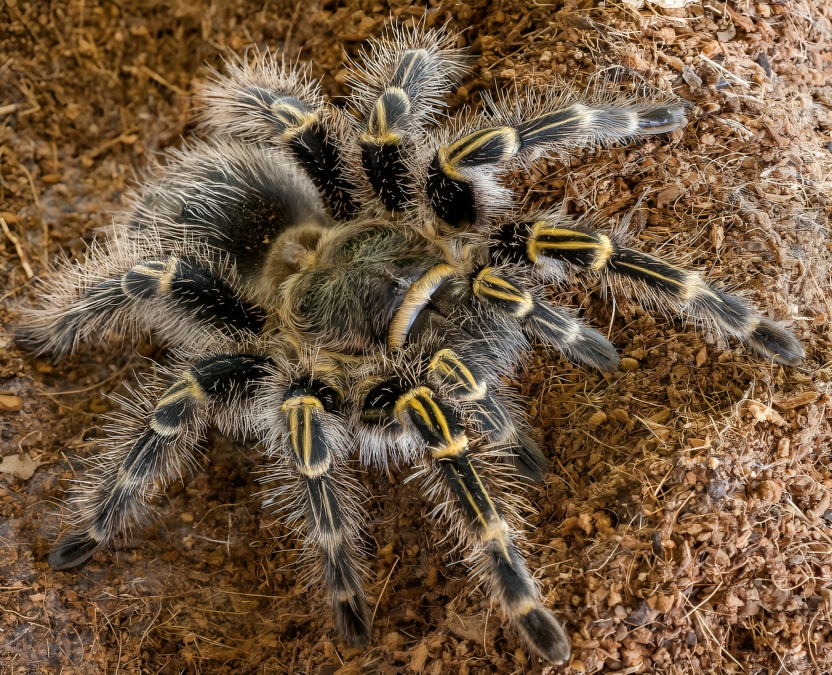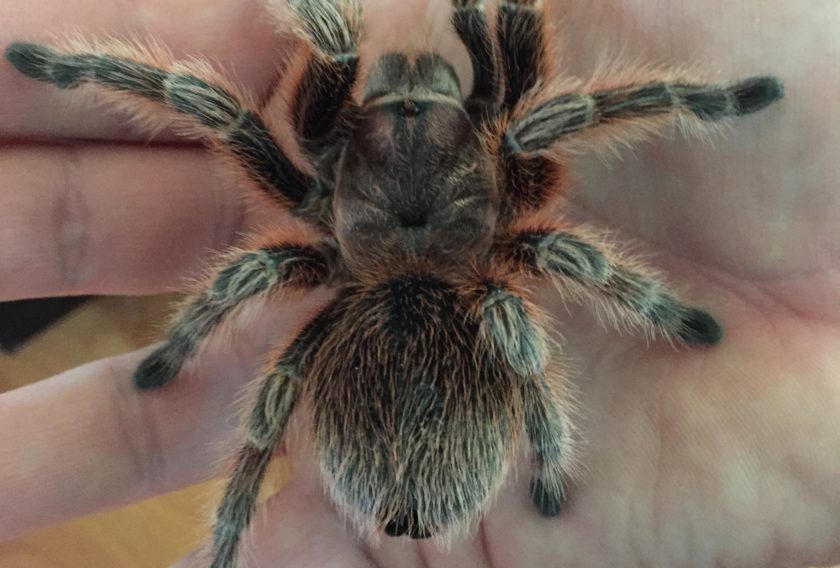The Chaco Golden Knee is one of the most popular tarantulas among novice keepers. To care for a Chaco Golden knee tarantula as a pet, you should pay attention to its enclosure, diet, and handling.
The scientific name is Grammostola pulchripes while it is commonly known as Chaco Golden or Chaco Striped Knee. It exhibits a multitude of colors such as brown, black, yellow, and golden colors on its body.

Originating from the dense forests of South America, particularly in regions like Paraguay, Uraguay, and Argentina, the Chaco Golden Knee Tarantula is a terrestrial creature, meaning it prefers to dwell in shrubs and surfaces. It can withstand easily alternating climate changes from dry to rainy due it its natural habitat environmental conditions.
This stunning tarantula has dark brown and black femurs with blonde stripes on its “knees”. This terrestrial species has large fangs which it raises to show its defensive mode.
Chaco Golden is a wonderful beginner-friendly tarantula as it is easy to care for, handle, and rehouse. The Chaco Striped Knee has rudimentary eyesight and it senses the environment with setae all over its body. These setae pick up the vibrations and create chemical signatures that are similar to the sense of smell.

The Chaco Golden makes a wonderful display tarantula as it loves to move around from bottom to top, inside its terrarium.
MALE VS FEMALE
One of the most intriguing aspects of the Chaco Golden Knee Tarantula is its sexual dimorphism. Mature females are typically larger and bulkier than males, with distinct golden bands adorning their legs. Males, on the other hand, are smaller and possess tibial hooks on their front legs, which they use during mating rituals.

Behavior
Chaco Golden Tarantula is adored for its calm and docile nature. The Spiders do not have feelings so it is more likely that they will not make an emotional bonding with you, unlike other pets such as dogs and cats.
These friendly creatures are cute, cuddly, and calm when handled which makes them a fascinating classroom pet.

It is quite tolerant of variations in its surroundings. Tarantulas have a venomous bite but its venom doesn’t cause any serious harm to humans. The tarantula’s principal defense is their ability to spray irritating urticating hairs.
As this species of tarantula is human-friendly, it prefers to run away rather than using its defense mechanism. You will forget your arachnophobia with this fascinating arachnid as your pet!!
Exercise
Like any other animal, the Chaco Golden tarantula also needs physical exercise for its optimum growth and fitness. A sufficiently large enclosure of the tarantula provides it enough space for roaming, burrowing, and climbing, it does not require excessive exercise.
Grooming
The Chaco Striped Knee undergoes a process in which it sheds its exoskeleton. This natural process keeps it well-groomed. This process is known as Molting.
Up Keep Cost
The Chaco Golden Tarantula is a low-maintenance tarantula and requires to be fed less frequently. The amount for its feed can be around $10-$20 per month which can be further reduced by raising the crickets on your own rather than getting from a pet store.
Moreover, there can be some expenses for changing the substrate and broken items. Also budget for the cost of the veterinary services and emergency conditions.
How To Care For A Pet The Chaco Golden Knee Tarantula?
The owner of the South American Chaco Golden Knee tarantula needs to provide less care for it. To extend the life of your pet tarantula, you can replicate their natural habitat, provide them with a healthy diet, maintain the required range of temperature and humidity, and take care of any health issues.
Chaco Golden Knee Tarantula Enclosure
Creating a suitable habitat for your Chaco Golden Knee Tarantula is essential for its well-being. A spacious terrarium with plenty of vertical space for climbing is ideal, as these tarantulas love to explore their surroundings.
The substrate should be a mixture of peat moss, vermiculite, and coconut fiber to maintain proper humidity levels. Keep the temperature between 75-85°F with humidity levels around 70-80%. Regular misting of the enclosure helps recreate the tarantula’s natural habitat.

Size Of The Habitat
The natural habitat of Chaco Golden tarantula is adaptable to different environmental changes from dry to rainy reasons. The enclosure of the tarantula should replicate the natural environment with adequate temperature and humidity levels.
A glass or plastic terrarium of nearly 10-15 gallon capacity with a deep layer of substrate should be used for adult Chaco Golden tarantulas and a small container is preferred for spiderlings and juvenile tarantulas.
The terrarium of the tarantula should be well secured so as to avoid any escape. The magnetic lock system is a good option for it. You should avoid a mesh lid in the terrarium because there is a probability that your Golden Knee’s feet would get struck in the mesh.
It will either fall or hang upside down. Moreover, the cage should have a secure lid that avoids any escape along with a movable system to serve food.
Substrate Requirements
The house of the tarantula should be well-ventilated. The base of the tarantula cage can be made with coconut mulch, organic soil and ABG mix(A premix bag that contains finely ground tree fern fiber, milled long fiber sphagnum moss, milled sphagnum peat moss, fine charcoal, and fine fir bark. The bag is made individually guaranteeing the correct ratios).
Required Temperature And Humidity Range
The Chaco Golden tarantula does well at room temperature of 68-74 degrees F
If the temperature drops during night time, a heat mat can be used on one side of the glass enclosure. The humidity level in the tarantula crib should be around 65-70% and should be checked with a humidity gauge. The light color of the substrate is an indication of the dryness and misting with distilled water restores the moisture levels.

Specific Requirements For Spiderlings
As juveniles loves to shove the substrate, there should be substrate filled up to a depth of around 2-3”. The size of the enclosure should be taken small during initial phase and can be replaced by bigger ones as your Chaco grows. The growth rate of Chaco golden is slow so you won’t have to frequently rehouse it.

Diet Of Chaco Golden Knee Tarantula
In the wild, Chaco Golden Knee tarantulas are opportunistic hunters, preying on a variety of insects including black crickets, brown crickets, cockroaches, dubia roaches, discoid roaches, red runner roaches and moths.
As captives, they thrive on a diet of appropriately sized live insects, such as crickets, mealworms, and Dubia roaches, offered once or twice a week. It is crucial to ensure that their prey is gut-loaded and dusted with essential nutrients and promote overall health.
They are ambush predators; they sit in wait, strike approaching prey, and quickly inject venom to immobilize it.
To keep these Striped Knee tarantulas healthy and satisfied, a live prey can be given. It’s essential to provide live prey to stimulate the tarantula’s hunting instincts and promote natural behaviors.
Feeding
In captivity, a varied diet consisting of crickets, mealworms, cockroaches, and occasional treats such as waxworms, frogs, or frozen pinky mice will help ensure nutritional balance.
Crickets
Tarantulas love crickets as food, and you can easily find them at your neighborhood pet store. Vita-Bugs crickets are boosted with beta-carotene, vitamin E, vitamin A, and omega-6 and omega-3 fatty acids, adding to their excellent nutritional content.

Red Runner Roaches
Another excellent choice is red runner roaches. Red Runners are very nutritious as they have a high meat to shell ratio containing 37% protein and 6% fat making them very similar to a cricket nutritionally.
Mealworms
Although mealworms and waxworms are high in calcium, phosphorus, and protein, their high-fat content means that feeding amounts should be controlled. The large super worms, green hornworms, red runners, or any other large invertebrate feeder can also be given at times.
Grasshoppers
Grasshoppers are very nutritious. They’re about 40 percent protein, 43 percent fat, and 13 percent dietary fiber.

Diet Schedule
As the tarantulas are nocturnal hunters, therefore it is always advisable to provide live food to it rather than serving a pre-killed dinner. The spiderlings can enjoy pre-killed food but adult tarantulas like to hunt.
The amount to be fed in a given interval of time depends on the size of the tarantula and its growing state. Tarantula shows rejection of food during molting, change of habitat, and in a state of stress. The uneaten food should be removed from its enclosure as it may cause stress and injury to your tarantula.
Handling
Handling Chaco Golden Knee Tarantulas can be an exhilarating experience, but it’s essential to proceed with caution and respect the tarantula’s boundaries. Always approach them calmly and avoid sudden movements to prevent stress.
When handling, support their weight and avoid dropping them, as they are delicate creatures. Not all tarantulas enjoy handling, so it’s crucial to observe their behavior and handle them sparingly, if at all.
If needed, encourage the tarantula to move using a soft brush rather than your hands. One should not exhale or blow on to the tarantula as moving air will spook it and make it more stressful. You will notice that your tarantula is raising and exposing its fangs under stress.

If you observe a shrunken abdomen with a wrinkled appearance, it is an indication of dehydration. Extra care is needed during the process of molting in which a tarantula sheds its skin. One should never hold a tarantula after molting as its skin is quite tender and food should not be given for at least three days after molting as touching the food may also be fatal.

Interesting Facts About Chaco Golden Knee Tarantula
Despite their intimidating appearance, Chaco Golden Knee Tarantulas are known for their gentle demeanor, rarely displaying aggression unless provoked.
- It is one of the calmest spiders.
- It has slow growth rate, so it may take years to see the adult coloration.
- It is a notorious species. At times ,it fills substrate in its water dish.
- During night time , it rearranges everything inside its enclosure.
- It is a curious tarantula, on sensing slight vibrations it starts exploring out.
- It loves to climb up the walls and top of enclosure.
Related Species
Grammostola pulchripes, commonly known as the Chaco golden knee tarantula, belongs to the Grammostola genus, which includes several other species of tarantulas. Some related species within the genus Grammostola include:
- Grammostola rosea (Chilean rose tarantula)
- Grammostola porteri (Brazilian black tarantula)
- Grammostola aureostriata (Chaco golden stripe tarantula)
- Grammostola grossa (Pampas Tawny Red Tarantula)
- Grammostola iheringi (Entre Rios tarantula)
These are just a few examples of species within the Grammostola genus, each with its own unique characteristics and habitats.
Tarantula Communities
You can find like-minded people having a strong affinity towards these beautiful arachnids and you can join them by clicking on the following links.
- https://www.facebook.com/groups/thetarantulacommunity/
- https://www.tarantulasoftheworld.com/tarantula-communities/
- https://www.thebts.co.uk/forums/index.php
Where To Buy Chaco Golden Knee Tarantula?
The Chaco Golden Knee Tarantula is a mesmerizing creature that continues to capture the hearts of arachnid enthusiasts worldwide. The Golden Striped Tarantula is the most popular among novice hobbyists and can be purchased from reputable breeder or exotic pet rescue organisations.
The cost of the Chaco Golden lies in an affordable range. The average cost of this Tarantula is between $20- $40.



